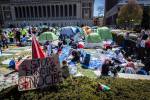Cleanup of world’s worst nuclear disaster since Chernobyl taking longer than first thought
TOKYO — The utility company that operated the Fukushima Daiichi nuclear plant in Japan — the one that went into triple meltdown after the enormous 2011 earthquake and tsunami — has released some jaw-dropping figures.
The radiation level in the containment vessel of reactor two has reached as high as 530 sieverts per hour, Tokyo Electric Power Co, or Tepco as it’s known, said last week. This far exceeds the previous high of 73 sieverts per hour recorded at the reactor following the March 2011 disaster.
That was the world’s worst nuclear disaster since the one at Chernobyl, in Ukraine, in 1986. Almost 16,000 people were killed along Japan’s northeastern coast in the tsunami, and 160,000 more lost their homes and livelihoods. The cleanup is taking much longer than expected.
At this level of radioactivity, a person could die from the briefest of exposures.
Tepco recorded the radiation near the reactor core, suggesting that some melted fuel had escaped, using a long, remote-controlled camera and radiation measurement device. It was the first time this kind of device has been able to get into this part of the reactor. There, it found a three-foot-wide hole in a metal grate in the reactor’s primary containment vessel.
So, how dangerous is this?
At this level of radiation, a robot would be able to operate for less than two hours before it was destroyed, Tepco said.
And Japan’s National Institute of Radiological Sciences said medical professionals had never even thought about encountering this level of radiation in their work.
According to Kyodo News Agency, the institute estimates that exposure to one sievert of radiation could lead to infertility, loss of hair and cataracts, while four sieverts would kill half of the people exposed to it.
This measuring device hasn’t even gone into reactors one and three yet - that’s still in the works.
So should the people who live in Japan, who live on the Pacific basin be freaking out?
Not yet, some analysts say.
Although the radiation level is “astoundingly high,” says Azby Brown of Safecast, a citizen science organization that monitors radiation levels, it doesn’t necessarily signify any alarming change in radiation levels at Fukushima. It’s simply the first time they’ve been measured that far inside the reactor.
Here’s what Brown wrote on Safecast’s website:
“It must be stressed that radiation in this area has not been measured before, and it was expected to be extremely high. While 530 Sv/hr is the highest measured so far at Fukushima Daiichi, it does not mean that levels there are rising, but that a previously unmeasurable high-radiation area has finally been measured. Similar remote investigations are being planned for Daiichi Units 1 and 3. We should not be surprised if even higher radiation levels are found there, but only actual measurements will tell.”
Hiroshi Miyano, nuclear expert and visiting professor at Hosei University, also warned against overreacting. He said the radiation reading might not be particularly reliable since it was only an estimation based on the image analysis. (Tepco said there was a margin of error of 30 percent.)
“It’s not something new to worry about,” he said, although he added that it underscored how difficult the next steps would be.
But some think there is cause for concern.
Fumiya Tanabe, nuclear safety expert and former chief research scientist at the Japan Atomic Energy Research Institute, said while experts expected the radiation reading inside the Daiichi reactors to be high, it was still “shocking” to learn how high it was six years on.
“It will be very difficult to operate robots in there for a long time to come, and to remove the melted fuel. So the finding might greatly affect the decommissioning time schedule,” he said.
Tepco had been hoping to start taking out the fuel out in 2021.
Could the radiation level be even higher?
Possibly. The 530 sievert reading was recorded some distance from the melted fuel, so in reality it could be 10 times higher than recorded, said Hideyuki Ban, co-director of Citizens’ Nuclear Information Center.
He agreed with Tanabe, saying that the findings underscore how difficult the decommissioning process will be.
“It definitely shows the path towards decommissioning will be very difficult, and the time frame to start taking out the fuel in 2021 will most likely be delayed as more investigations will be necessary,” Ban said.
Still, he cautioned against overreacting, saying, like Brown, that Tepco had simply not been able to measure this close to the fuel before.
So what does this news portend?
The level of the reading should give proponents of nuclear power in Japan - including Prime Minister Shinzo Abe, who’s been pushing to restart reactors shut down after the 2011 disaster - pause, Tanabe said.
“It’s unbelievable that anyone would want to restart nuclear plants when Japan hasn’t learned how and why the Fukushima Daiichi accident happened, or learned lessons from it,” he said.
Indeed, Ai Kashiwagi, an energy campaigner at Greenpeace Japan, said the findings showed how little the government and Tepco knew about what was happening inside the reaction.
“The prime minister said everything was under control and has been pushing to restart nuclear plants, but no one knew the actual state of the plant and more serious facts could come out in the future,” she said. “It’s important to keep an eye on radiation-monitoring data and how Tepco’s investigations go.”




























